Roll film cameras
 Roll film is photographic film that is openly assembled on a spool. The designation arose in contrast to plan film. The most well-known roll film is type 120, which is used in most medium format cameras and in roll film magazines for large format cameras. Even today, roll film is still the first choice for many amateur and professional photographers when it comes to expressive pictures.
Roll film is photographic film that is openly assembled on a spool. The designation arose in contrast to plan film. The most well-known roll film is type 120, which is used in most medium format cameras and in roll film magazines for large format cameras. Even today, roll film is still the first choice for many amateur and professional photographers when it comes to expressive pictures.
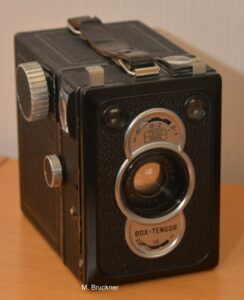
Box cameras were the simplest form of camera before and shortly after World War II.
Pictures could be taken on different roll film formats with a moment time of approx. 1/30 sec. and a simply designed lens.
With sufficient sunlight and calm subjects, it didn’t even work that badly.
My beautiful Zeiss Ikon Box Tengor from 1938 also offered three levels of aperture and distance adjustment. A “B” setting for time recordings of any length can also be selected.
With the 120 roll film, eight pictures in the format 6 x 9 cm could be exposed.
There is a separate viewfinder for portrait or landscape format. The large image format has the advantage that even inexpensive contact copies are sufficient for acceptably large prints.

With the successful Clack and Click models, Agfa made the transition from the simple box cameras, whose appearance was no longer salable in the early years of the economic boom. The Agfa Clack, introduced in 1953, takes pictures in landscape format 6 x 9 cm and was Agfa’s first camera made primarily of plastic. A single meniscus lens, in conjunction with the curved film path, should ensure distortion-free images. Two f-stops and a close-up lens that can be swiveled forward for a range between one and three meters gave the photographer scope for different recording and lighting situations. The exposure time was fixed at approx. 1/30 second, alternatively „B“ could be selected for time exposures of any length.

The Agfa Click presented in 1958 exposes in the format 6 x 6 cm on roll film 120 (corresponds to 12 frames per film). The lens is an improved Agfa achromat with a maximum aperture of 8.8. Two f-stops and a close-up lens are built in. The Click came very close in appearance to a „real“ camera and could be produced and sold with a few modifications until 1970 (finally in India).
 Taking photos with one of the two „pseudo cameras“ is still possible today without any problems, preferably with a low-light-sensitive film up to a maximum of 100 ASA. When the weather is reasonably nice and the yellow filter is attached (on the click), you get well-exposed photos with real 1950s charm.
Taking photos with one of the two „pseudo cameras“ is still possible today without any problems, preferably with a low-light-sensitive film up to a maximum of 100 ASA. When the weather is reasonably nice and the yellow filter is attached (on the click), you get well-exposed photos with real 1950s charm.

A popular camera in the early 1950s were the Agfa Billy models, here the Billy 1 from 1953.
“The construction is rock-solid, the shape handy. Thanks to the tried-and-tested spring-spreading mechanism, we have the rapid receptiveness. An excellent, anti-reflective lens, the Agfa Agnar, ensures clear and sharp-edged negatives. Of course you can also flash with the Agfa Billy I.”
proclaims a contemporary prospectus. Added to this was the affordable price and the long tradition of Agfa. which had the first Billy camera in its range as early as 1928. The Billy 1 was able to hold its own on the market until 1960 with nice extras such as the folding support, the modern telescopic viewfinder and the flash synchronization.
 For Christmas 1953, Mr. Greveler, who I do not know, bought a much better equipped camera. Not just one of the most beautiful folding cameras, but also a flash unit, seven flash bulbs, a battery, a cable release and one! Film was bought for DM 175.81 from the Schmelter photo shop in Münster. I don’t know whether Mr. Greveler exposed more than one film, but it couldn’t have been many, because his
For Christmas 1953, Mr. Greveler, who I do not know, bought a much better equipped camera. Not just one of the most beautiful folding cameras, but also a flash unit, seven flash bulbs, a battery, a cable release and one! Film was bought for DM 175.81 from the Schmelter photo shop in Münster. I don’t know whether Mr. Greveler exposed more than one film, but it couldn’t have been many, because his
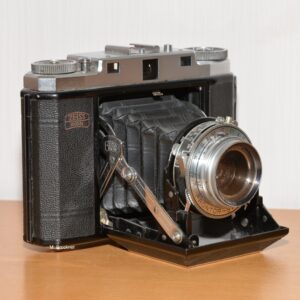
Zeiss Ikon Mess-Ikonta 6×6, which I bought 60 years later at a well-known online auction house for little money, still looks fresh from the store.
The Ikonta has almost everything a photographer’s heart desires: a sharp lens, a rangefinder and the much-vaunted quality that characterized the Zeiss Ikon cameras at the time. The Prontor-SV shutter offers exposure times from 1 second to 1/300 second including the „B“ setting. The Novar lens with three lenses and an aperture range of 4.5 to 22 has enough reserves even for cloudy days. And you can flash at any set exposure time. The image format of 6 x 6 cm leaves plenty of scope for image design in the enlargement laboratory. All in all a well-equipped camera, for which I am very grateful to Mr. Greveler.
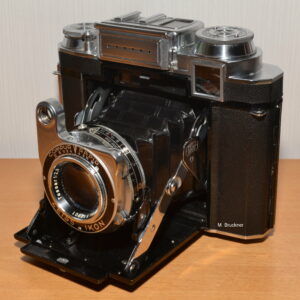
The pinnacle of Zeiss Ikon medium format rangefinder cameras was the Super Ikonta from 1929 to 1957. It was the first roll film camera with a built-in selenium exposure meter that was also easy to read from above.
The large and heavy device usually has a Zeiss Tessar 80 mm f/2.8 lens in the Compur shutter, an automatic counter for the number of exposures and a lock against double exposures. The camera body is made of cast light metal. The rangefinder based on the rotating wedge principle (an extremely precise measuring device developed by Zeiss Ikon) is coupled to the lens and can be adjusted in the viewfinder. In the course of production, the Super Ikonta was repeatedly improved. My well-kept copy is from 1950, so it already has a fully coated Zeiss-Opton Tessar in the Compur-Rapid shutter, which is only synchronized for electronic flash units. The shutter speeds: B and 1 to 1/400 second. The sharply defined Tessar in connection with the large initial aperture still ensures excellent images in the 6×6 cm negative format today.
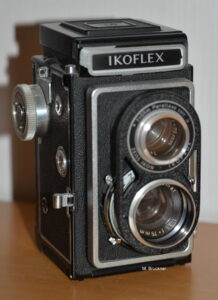
In the sector of twin-lens reflex cameras, Zeiss Ikon had a camera series in direct competition with Rollei up to 1955: the Ikoflex.
My Ikoflex Ia was the cheapest model in the series. With a three-element Novar Anastigmat lens with a maximum aperture of 3.5 and the Prontor SV shutter, you are still well equipped for most photographic tasks. The distance setting is no problem with the bright waist-level viewfinder. The attachable close-up lens extends the close-up range to 0.5 meters with automatic parallax compensation. A handheld exposure meter should definitely be consulted. The Ikoflex convinces with a dignified processing. The only weak point: In the 1950s, roll film spools were a bit thicker than they are today, which means that the negatives overlap when the film is transported automatically. Two strips of insulating tape around the take-up spool can help.
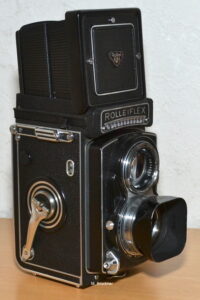
According to a price list from 1962, the Rolleiflex T, Rollei’s middle class, cost an impressive DM 784. In return, the proud owner received an extremely robust, versatile camera that left nothing to be desired except for an interchangeable lens. The light meter works with two areas and the Tessar lens ensures edge-sharp images. The film is transported with a turn of the crank and the shutter is cocked at the same time. However, the biggest advantage of the Rolleiflex T is the simple conversion to different picture formats. As a standard, the 120 roll film can be used to expose twelve images in the 6 x 6 cm format. With the separately available mask set, the Rolleiflex becomes a camera that takes 16 pictures in wide format 4 x 5.5 cm or in small square 4 x 4 cm (popular with slide photographers).
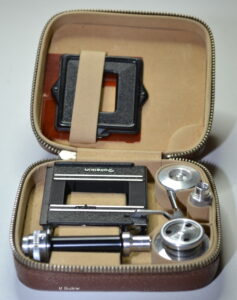 With the Rolleikin, the use of 35mm films is effortless. This creates portrait format negatives in the format 24 x 36 mm. Ideal for portraits or reports with high film consumption. Working with the Rolleiflex is a pleasure, the machine still works like on the first day even at the age of almost 60 years. It’s just a shame that Rollei never offered interchangeable lenses for its twin-lens cameras.
With the Rolleikin, the use of 35mm films is effortless. This creates portrait format negatives in the format 24 x 36 mm. Ideal for portraits or reports with high film consumption. Working with the Rolleiflex is a pleasure, the machine still works like on the first day even at the age of almost 60 years. It’s just a shame that Rollei never offered interchangeable lenses for its twin-lens cameras.
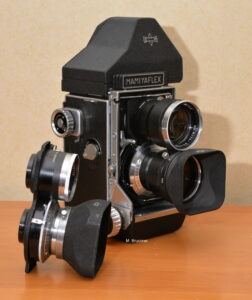
Starting in 1960, Mamiya showed how the construction of interchangeable lenses on a twin-lens reflex camera can be realized with little effort with the Mamiyaflex models.
The Mamiyaflex C 2 feels like it’s built to last. Big, heavy and a little unwieldy. So just right for people who want to earn money with their camera. The long bellows enables close-ups of up to 40 cm with the 80mm lens, parallax marks are etched into the bright viewfinder.
The shutter on the lens has to be tightened separately, this has also been improved in later series. The lens change works quite foolproof. A light flap reliably shields the film from extraneous light.

In 1975 Mamiya started the 645 series with a negative size of 6 x 4.5 cm. Initially derided as Poor men’s Hasselblad, the new camera series was soon able to convince many amateurs and professionals of its qualities. Designed from the outset as an expandable camera system, Mamiya’s first version offered three camera bodies with different performance, four viewfinder systems and eleven interchangeable lenses in the range from 35 to 500mm. The electronic focal plane shutter in the Mamiya 1000 S works in a range from 8 seconds to 1/1000 seconds. Infinitely adjustable front drive, mirror locking and the option of making double exposures complete the good impression. All this is built into a solid aluminum housing that easily withstands the rough everyday life of a professional.
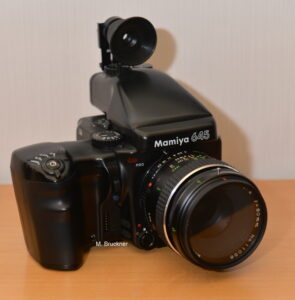
The Mamiya 645 Pro, introduced in 1993, continued the success of its predecessor, the M645 Super camera, with a new design.
All other good properties were retained. Particularly noteworthy is the ability to use removable magazines. There are four types to choose from: 15-frame 120 roll film, 30-frame 220 roll film, 35mm film and Polaroid FP instant photos. Also new to the range was a fisheye lens, two fast telephoto lenses and three lenses with a central shutter for flash photography. The Mamiya 645 series was further developed as an analog camera until around 2008. With the attached motor handle, the heavy device fits comfortably in your hand and allows image sequences every second.
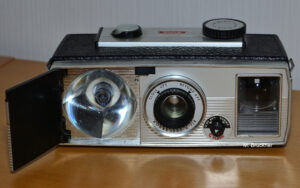
Kodak had a nice camera for 127 roll film in its range in the early 1960s: the Brownie Super 27. The built-in flash unit was hidden behind a flap. The camera itself is quite spartan. Two times (sunny and cloudy) and two distances (close-up and over 3 feet) have to suffice for the photographer to take a picture with the built-in plastic lens. In the course of the conversion to the Instamatic system, the Kodak roll film cameras then disappeared from the range after 1965.
Go to Minox or start page
